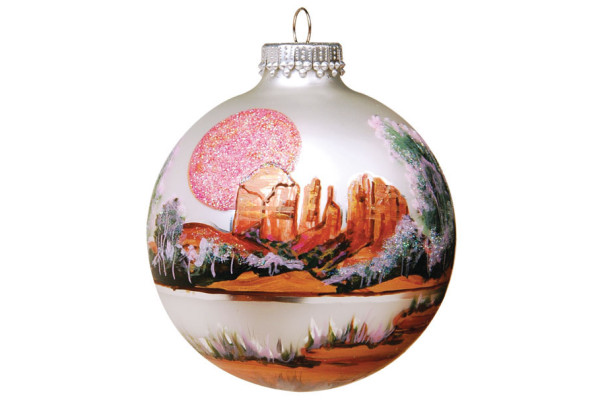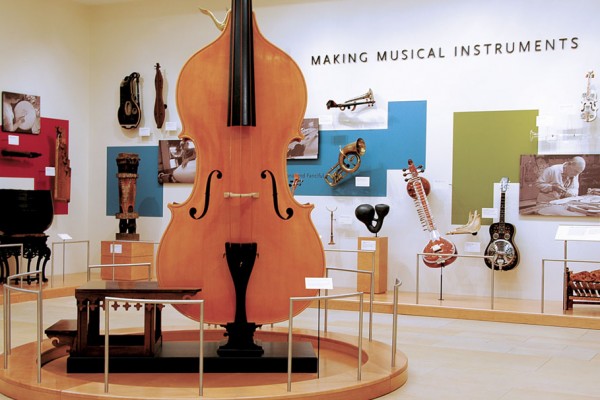Continued (page 2 of 3)
Two years ago, Lena began weaving full time. She says she works every day – “after I’m done with the cooking” – sometimes for stretches as long as 10 hours, sitting on the floor in front of her loom (with country music, often George Jones, playing in the background). Depending on the size of the rug, it can take up to one year to prepare the wool and complete the weaving. During our visit, she was working on a rug design featuring horses. “I’ve been working on these horses all week,” she says. “My son is my critic – he told me the horse looked like a donkey, so I had to take it out and start again.”
One of Lena’s sisters, Marilou Schultz, lives in Mesa, Ariz., and specializes in dying her own wool using aniline and vegetable dyes. She travels all over the country, experimenting with different plants and creating variegated dyes. Lena says these days she purchases most of her wool from Marilou. She says it’s the wool and the different colors that provide the most inspiration, and though she will weave traditional rugs in designs including the Storm pattern and Two Grey Hills, she prefers more contemporary designs such as her horse pictorial or the vibrant Germantown pattern that was stretched on a different loom in her living room. Lena’s rugs range in size from 14 inches by 12 inches all the way up to 70 inches by 47 inches.
Melissa has a penchant for the Germantown (also called “eyedazzlers” because of the rugs’ bright colors) pattern while some of her other designs are asymmetrical and feature psychedelic colors. Germantown rugs were originally woven in the late 1800s after the Navajos’ internment at Fort Sumner in New Mexico. The rugs are named after an area near Philadelphia where it’s believed the three- and four-ply machine-spun wool yarn used in rugs from this time period originated. Melissa agrees that not all Navajo weavers are pleased with what’s being produced by their younger counterparts, but she says designs change with the times.
“The newer generations are drawn to the brighter colors,” says Melissa. “I also see it as a celebration that we’ve moved on from that period. We have an appreciation for the style and now view it in a positive light. People are afraid the younger generation isn’t going to take up traditional art forms and languages, whereas this can be used as a way to prolong those cultural values.”
“I think that’s how my mom sees [Melissa’s] style of weaving,” says Lena, sitting on a couch nearby. “She’s glad the younger ones are learning. She’s always anxious to see what [Melissa] is working on. We know it’s going to be different.”
“That’s always an uplifting thing for someone who’s just starting out,” says Melissa. “At times you have the weary feeling of, Am I going to be looked down upon for going outside of the box or will I be embraced? To have my aunts embrace it is very uplifting.”
Melissa has been weaving since she was 5, and she’s woven two or three rugs every year since she was 8. She started out with traditional designs but began to branch out in high school. She left Arizona to study fine art at the Institute of American Indian Arts in Santa Fe. After she received her degree, she worked at the institute’s museum until recently returning to northern Arizona. Thanks to her young age and her bright designs, Melissa has received quite a bit of buzz in the art world. In February, she was featured in Native Peoples magazine. She also traveled to South Africa with her mom as part of an artist delegation exchange program where she learned about weaving in Lesotho and Swaziland. Rugs that were inspired by her dad’s battle with Parkinson’s disease were exhibited in Victoria, British Columbia. She also shows her work at the Navajo Festival of Arts and Culture at the Museum of Northern Arizona, Santa Fe Indian Market and the Indian Fair & Market at the Heard Museum (this year, she won the Conrad House Award at the market). Next month, Melissa will travel to the University of Nebraska for textile workshops. Melissa’s formal art education has influenced her working methods: She sketches out her designs first for later reference; in contrast, Lena keeps everything in her head.
The design process isn’t the only area where the two women are different. Lena says it’s hard to say goodbye to a rug once it’s been sold. “People don’t understand the process and how long it takes,” says Lena, who doesn’t keep her own weavings but proudly displays one of her daughter’s rugs above the couch. “I always want to know who bought it and where it’s going.”
Melissa doesn’t feel the same. “Once it’s off the loom, I’m pretty much ready to let it go,” she says. “I like the excitement of what’s new and what’s the next thing on the loom.”
Melissa says there is a demand for rugs that deviate from the traditional designs such as Chinle, Burntwater, Teec Nos Pos, Wide Ruins and Ganado. The traditional designs are specific to different regions on the Navajo reservation, but living in an area like Birdsprings where there isn’t a set pattern opens the door for creativity, say Melissa and Lena.



